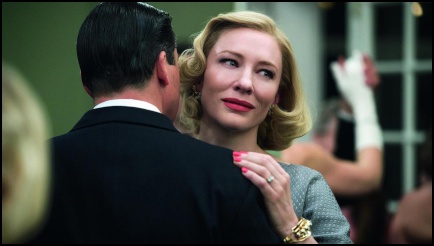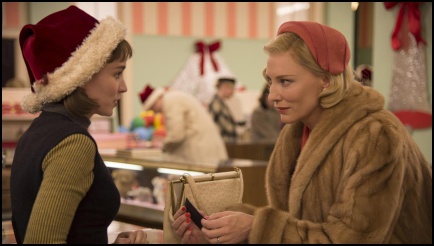Venus in Fur -
Todd Haynes'
'Carol'
Howard DavisAt a total running time of almost two hours, 'Carol' is a long, slow, languorous exercise in chemically-pure visual cinema. Just as Nastassja Kinski saved Roman Polanski's 'Tess' from becoming a gorgeous snooze-fest, it's really only Kate Blanchett's luminous and gimlet-eyed performance that prevents 'Carol' from lapsing into total lethargy. She's a stellar actress who realized early on the truth of Dirk Bogarde's comment that the camera always seems to know what actors are thinking, even when they're not thinking about anything in particular. Rooney Mara's predominantly puzzled expression throughout the movie only reflects the indecision and inner confusion that delays the belated discovery of her sexuality.
The real "star" of the show, however, is the attention lavished not only on Judy Becker's dressing of exterior locations and Heather Loeffer's interior sets, but also Sandy Powell's sumptuous costumes. The pitch-perfect period detail is lushly amplified by the soundtrack, replete with classic tunes by Anne Ross, Gerry Mulligan, Eddie Fisher, Teddy Wilson and Billie Holiday.

The sinuously luxurious automobile rides that punctuate the narrative arc predate the cross-country road-trip in 'Lolita,' during which Humbert Humbert gradually seduces (and eventually loses) the nymphet Dolores in a series of increasingly grimy motel rooms. Similarly, Carol drives the gamin Therese deep into the heartland on their odyssey of self-discovery. It's significant that both are trailed (and ultimately undone) by their respective nemeses while on the road - the shadowy and ambiguously-named Clare Quilty in Nabokov's novel (first published in Paris in 1955 and the US in 1958) and a creepy private detective in Patricia Highsmith's (1952).
Both journeys inherit the mythic mantle of a venerable historical and literary tradition of pioneering treks into the hinterland of the American imagination. From the founding impetus of the original colonists, through the epic adventures of Huck Finn and Jack London, to Jack Kerouac and the seminal TV series 'Route 66' the westward flight for freedom has always been driven by a desire to escape the claustrophobic confines of a repressed and repressive society, threatened by any evidence transgression and/or difference.
In order to recreate the grainy texture and feel of films from the late 40s and early 50s, director Todd Haynes shot the movie on Super 16mm, adapting his cinematic references from Ruth Orkin's and Morris Engel's "Lovers and Lollipops" (1956). Ed Lachman's superb cinematography was influenced by the photojournalism and urban photography of Vivian Maier, Helen Levitt, Esther Bubley, and Ernst Haas. The photographs of Saul Leiter, renowned for shooting through windows and using reflections, are also clearly alluded to, as are Douglas Sirk's Technicolor melodramas and Rainer Werner Fassbinder's skillful use of screens and soft focus to suggest a constant sense of alienation and separation between characters.

As far back as his 1995 drama 'Safe,' Haynes has created image books culled from photographs, film stills, paintings, and periodicals as guides to the visual style of his films. These compendiums are meant initially for the cinematographer and Haynes has described them as "a way of communicating beyond words that gets to the crux of what the mood, temperature, and stylistic references would be." He assembles his image books as a visual mix-tape, collecting photos and movie screen grabs of his inspirations and combining them to create a kind of virtual movie, wreathed in cigarette smoke and laced with martinis.
Haynes took two months to compile more than eighty pages of these photo-collages for 'Carol,' which then served as a road-map throughout the production. They influenced "clothes, hair, makeup, the way women carry themselves in the period and the specificity of how they're being created from the outside in." The image book for 'Carol' included shots from David Lean's 'Brief Encounter' and Alfred Hitchcock's 'Vertigo' for their sense of period; the innovative cinematography of Vilmos Zsigmond in 'The Sunderland Express'; and Jack Clayton's deployment of interior space in 'The Pumpkin Eater.'
Phyllis Nagy's deliciously and deliberately andante screenplay is an adaptation of Highsmith's erotically intoxicating novel "The Price of Salt." Inspired by a chance encounter with a glamorous blond in a fur coat, while she was working as a temporary clerk selling dolls in a New York department store shortly before Christmas 1948, Highsmith completed the outline in two hours that same night - possibly under the influence of chicken pox, which she discovered she had contracted the following day, commenting "fever is stimulating to the imagination."
Eventually completed three years later and published under the alias Claire Morgan, the novel sold more than a million copies. For thirty-eight years Highsmith denied rumors she was the author, until she agreed to the publication of a new, retitled edition and wrote an afterword. It wasn't until 1990 that 'Carol' was finally published in England under her own name, a testament to the sense of anxiety surrounding the depiction of homosexuality, still lingering over the subject like a miasmic vapor from the homogenized atmosphere of the Eisenhower's America.
Fortunately, times have changed. 'Carol' received a ten minute standing ovation at the Cannes Film Festival. With five nominations (but no wins), it was the most nominated film at the Golden Globes. Hopefully, it will be more fulsomely rewarded at the Academy Awards, where it's been nominated for six Oscars.



 Binoy Kampmark: Censorship Wars, Elon Musk, Safety Commissioners And Violent Content
Binoy Kampmark: Censorship Wars, Elon Musk, Safety Commissioners And Violent Content Gordon Campbell: On The Public Sector Carnage, And Misogyny As Terrorism
Gordon Campbell: On The Public Sector Carnage, And Misogyny As Terrorism Ramzy Baroud: NATO’s Never-ending War: The 75-Year-Old Bully Is Faltering
Ramzy Baroud: NATO’s Never-ending War: The 75-Year-Old Bully Is Faltering Eugene Doyle: Joining AUKUS Not In NZ’s National Interest
Eugene Doyle: Joining AUKUS Not In NZ’s National Interest Binoy Kampmark: The Australian Defence Formula, Spend! Spend! Spend!
Binoy Kampmark: The Australian Defence Formula, Spend! Spend! Spend! Ian Powell: New Hospital Building Trumps ‘Yes Minister’ Hospital Without Patients
Ian Powell: New Hospital Building Trumps ‘Yes Minister’ Hospital Without Patients